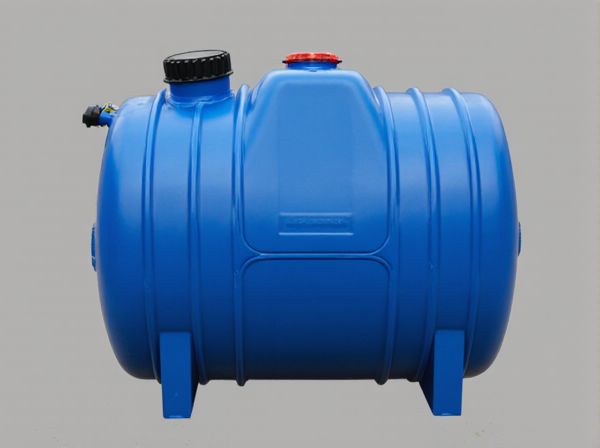
Photo illustration: Flexible Tank vs Rigid Tank
Flexible tanks offer lightweight, space-saving storage solutions that adapt easily to various shapes and environments, making them ideal for temporary or transport applications. Rigid tanks provide durable, stable containment with high resistance to impact and environmental factors, perfect for long-term storage and heavy-duty use. Choosing the right option depends on Your specific needs for portability, durability, and installation constraints.
Table of Comparison
| Feature | Flexible Tank | Rigid Tank |
|---|---|---|
| Material | High-grade synthetic rubber or reinforced fabric | Steel or hard plastic (polyethylene) |
| Weight | Lightweight, easy to install | Heavier due to solid construction |
| Durability | Moderate; susceptible to punctures and wear | High; resistant to impact and corrosion |
| Flexibility | Highly flexible; adapts to vehicle space | Rigid, fixed shape and size |
| Installation | Quick, can fit irregular spaces | Requires precise mounting and space |
| Fuel Capacity Options | Varies widely, customizable sizes | Standard sizes, limited flexibility |
| Cost | Generally lower initial cost | Higher cost due to materials and fabrication |
| Maintenance | Needs regular inspection for leaks | Low maintenance, durable over time |
| Use Cases | Off-road, temporary setups, trailers | Standard vehicles, long-term installations |
Introduction to Flexible and Rigid Tanks
Flexible tanks, made from reinforced materials such as PVC or rubber, offer lightweight and portable storage solutions ideal for temporary or mobile applications. Rigid tanks, typically constructed from steel or plastic, provide durable, long-lasting containment with superior structural integrity for storing liquids or chemicals. Both tank types serve specific needs based on factors like installation environment, capacity, and transportation requirements.
Core Differences Between Flexible and Rigid Tanks
Flexible tanks are made from durable, high-strength materials such as reinforced PVC or polyurethane, allowing them to bend and adapt to uneven surfaces, while rigid tanks are constructed from solid materials like steel or fiberglass, providing fixed structural integrity. Unlike rigid tanks, flexible tanks are lightweight, collapsible, and easier to transport and store when empty, making them ideal for temporary or mobile storage solutions. Rigid tanks offer superior durability, higher resistance to impact and environmental stress, and are better suited for long-term, stationary applications requiring consistent support and maintenance.
Material Composition and Durability
Flexible tanks are typically constructed from high-strength polyester fabric laminated with layers of polyurethane or PVC, offering excellent resistance to abrasion, UV exposure, and chemicals while maintaining lightweight and foldable properties. Rigid tanks are made from materials such as steel, aluminum, or fiberglass-reinforced plastics, providing superior structural strength and heightened durability against impact, pressure, and extreme environmental conditions. The choice between flexible and rigid tanks hinges on the specific application requirements, balancing material durability with transportability and ease of installation.
Installation and Setup Procedures
Flexible tanks offer quick, easy setup with minimal ground preparation and no heavy machinery, making them ideal for temporary or emergency storage. Rigid tanks require a stable foundation, precise leveling, and specialized equipment for installation, leading to longer setup times and higher labor costs. The straightforward deployment of flexible tanks provides significant advantages in accessibility and speed over rigid tanks.
Space and Storage Efficiency
Flexible tanks offer superior space efficiency by conforming to available storage areas, maximizing volume utilization in tight or irregular spaces compared to rigid tanks. Rigid tanks require a fixed, often bulky footprint that limits optimal storage density and can lead to wasted space. Flexible tanks also enable easier transport and temporary storage solutions, further enhancing overall space and storage efficiency in dynamic environments.
Cost Comparison: Flexible vs Rigid Tanks
Flexible tanks typically cost less upfront than rigid tanks due to lower material and manufacturing expenses. Maintenance and transportation costs for flexible tanks are also reduced, as they are lightweight and easier to handle compared to rigid tanks. However, rigid tanks may offer longer lifespans and greater durability, potentially lowering total ownership costs over time despite higher initial investments.
Maintenance and Longevity
Flexible tanks require minimal maintenance due to their lightweight, corrosion-resistant materials, reducing the risk of rust and structural damage commonly seen in rigid tanks. Rigid tanks, typically made from steel or fiberglass, demand regular inspections, cleaning, and protective coatings to prevent corrosion and ensure structural integrity over time. Flexible tanks tend to have shorter lifespans but offer easier, cost-effective replacement, while rigid tanks provide greater longevity if properly maintained with routine upkeep and repairs.
Safety Considerations and Risk Factors
Flexible tanks offer enhanced safety by absorbing shocks and reducing the risk of rupture during impact, making them ideal for transporting hazardous liquids with minimal spill potential. Rigid tanks, constructed from materials like steel or aluminum, provide superior structural integrity and resistance to punctures but may pose higher risks during collisions due to their rigidity and potential for brittle fracture. Risk factors in flexible tanks include material degradation from UV exposure and chemical compatibility, while rigid tanks require regular inspections for corrosion, weld integrity, and pressure containment to maintain safe operation.
Typical Applications and Use Cases
Flexible tanks are widely used for temporary storage and transportation of liquids such as water, chemicals, and fuels in industries like agriculture, firefighting, and oil exploration due to their lightweight and easy deployability. Rigid tanks, made from metals or reinforced plastics, suit permanent or semi-permanent installations in industrial, municipal, or commercial settings where structural integrity and long-term durability are critical. Typical applications include flexible tanks for emergency water storage or fuel transportation on remote sites, while rigid tanks are preferred for chemical processing plants, wastewater treatment facilities, and stationary fuel storage.
Choosing the Right Tank for Your Needs
Flexible tanks offer lightweight, portable storage ideal for temporary or remote applications, while rigid tanks provide robust, long-term durability with higher resistance to environmental stress. Consider factors such as capacity, installation environment, budget, and material compatibility when choosing between flexible and rigid tanks. Selecting the right tank ensures optimal performance, cost-efficiency, and longevity tailored to specific operational requirements.
 caratoz.com
caratoz.com